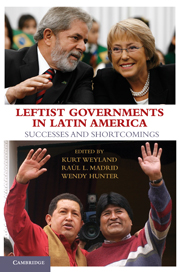Book contents
- Frontmatter
- Contents
- Acknowledgments
- Acronyms and Abbreviations
- Contributors
- 1 The Performance of Leftist Governments in Latin America: Conceptual and Theoretical Issues
- 2 The Repeating Revolution: Chávez's New Politics and Old Economics
- 3 The Challenge of Progressive Change under Evo Morales
- 4 The Chilean Left in Power: Achievements, Failures, and Omissions
- 5 From Cardoso to Lula: The Triumph of Pragmatism in Brazil
- 6 Lula's Administration at a Crossroads: The Difficult Combination of Stability and Development in Brazil
- 7 The Policies and Performance of the Contestatory and Moderate Left
- Bibliography
- Index
1 - The Performance of Leftist Governments in Latin America: Conceptual and Theoretical Issues
Published online by Cambridge University Press: 05 June 2012
- Frontmatter
- Contents
- Acknowledgments
- Acronyms and Abbreviations
- Contributors
- 1 The Performance of Leftist Governments in Latin America: Conceptual and Theoretical Issues
- 2 The Repeating Revolution: Chávez's New Politics and Old Economics
- 3 The Challenge of Progressive Change under Evo Morales
- 4 The Chilean Left in Power: Achievements, Failures, and Omissions
- 5 From Cardoso to Lula: The Triumph of Pragmatism in Brazil
- 6 Lula's Administration at a Crossroads: The Difficult Combination of Stability and Development in Brazil
- 7 The Policies and Performance of the Contestatory and Moderate Left
- Bibliography
- Index
Summary
The first decade of the third millennium has seen a striking move to the left in Latin America. After the victory of Hugo Chávez in Venezuela in December 1998, presidents who identify themselves and are widely seen as part of the left have been elected in Bolivia, Brazil, Chile, Ecuador, El Salvador, Guatemala, Nicaragua, Paraguay, and Uruguay, and leftists in Mexico and Peru came very close to accomplishing the same feat. Moreover, former Argentine president Néstor Kirchner, who represented the center-left wing of the ideologically heterogeneous and amorphous Peronist Party, won in 2003 against the exponent of the party's neoliberal wing, Carlos Menem. The current Argentine president, Cristina Fernández de Kirchner, who took over from her husband in 2007, occupies a similar position on the ideological spectrum. As a result, left-leaning presidents currently govern approximately two-thirds of the region's population.
This shift to the left constitutes a dramatic change from the 1990s, when the left elected barely any presidents in Latin America and when governments of various stripes enacted market-oriented reforms – the economic project of the right – in most countries of the region. At that time, the Washington Consensus on market reform was indeed the consensus approach among high-ranking policymakers, and although there always were organized interests, sectors of the population, and political parties (especially from the left) that rejected it, they were fairly marginalized in many nations and could at best exert defensive veto power.
- Type
- Chapter
- Information
- Leftist Governments in Latin AmericaSuccesses and Shortcomings, pp. 1 - 27Publisher: Cambridge University PressPrint publication year: 2010
- 17
- Cited by

